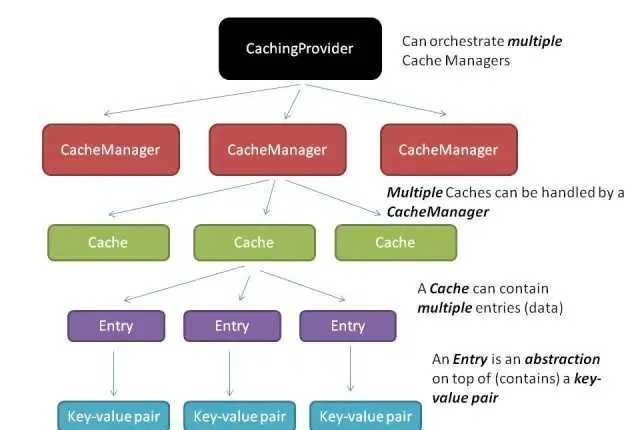Java 缓存中间件
关键词:Spring Cache、J2Cache、JetCache一 、JSR 107
JSR107 中制订了 Java 缓存的规范。
因此,在很多缓存框架、缓存库中,其 API 都参考了 JSR 107 规范。

Java Caching 定义了 5 个核心接口
CacheManager
。一个应用可以在运行期访问多个
CachingProvider
。
二、Spring Cache
详见: Spring Cache 官方文档Spring 作为 Java 开发最著名的框架,也提供了缓存功能的框架—— Spring Cache。
Spring 支持基于注释(annotation)的缓存(cache)技术,它本质上不是一个具体的缓存实现方案(例如:EHCache 或 OSCache),而是一个对缓存使用的抽象,通过在既有代码中添加少量它定义的各种 annotation,即能够达到缓存方法的返回对象的效果。
Spring Cache 的特点:
开启缓存注解
Spring 为缓存功能提供了注解功能,但是你必须启动注解。
有两种方式:
(一)使用标记注解
@EnableCaching
这种方式对于 Spring 或 Spring Boot 项目都适用。
@Configuration
@EnableCaching
public class AppConfig {
}
(二)在 xml 中声明
<cache:annotation-driven cache-manager="cacheManager"/>
spring 缓存注解 API
Spring 对缓存的支持类似于对事务的支持。
首先使用注解标记方法,相当于定义了切点,然后使用 Aop 技术在这个方法的调用前、调用后获取方法的入参和返回值,进而实现了缓存的逻辑。
@Cacheable
@Cacheable
用于触发缓存
。
表明所修饰的方法是可以缓存的:当第一次调用这个方法时,它的结果会被缓存下来,在缓存的有效时间内,以后访问这个方法都直接返回缓存结果,不再执行方法中的代码段。
这个注解可以用
condition
属性来设置条件,如果不满足条件,就不使用缓存能力,直接执行方法。
可以使用
key
属性来指定 key 的生成规则。
@CachePut
@CachePut
用于更新缓存
。
与
@Cacheable
不同,
@CachePut
不仅会缓存方法的结果,还会执行方法的代码段。
它支持的属性和用法都与
@Cacheable
一致。
@CacheEvict
@CacheEvict
用于清除缓存
。
与
@Cacheable
功能相反,
@CacheEvict
表明所修饰的方法是用来删除失效或无用的缓存数据。
下面是
@Cacheable
、
@CacheEvict
和
@CachePut
基本使用方法的一个集中展示:
@Service
public class UserService {
// @Cacheable可以设置多个缓存,形式如:@Cacheable({"books", "isbns"})
@Cacheable(value={"users"}, key="#user.id")
public User findUser(User user) {
return findUserInDB(user.getId());
}
@Cacheable(value = "users", condition = "#user.getId() <= 2")
public User findUserInLimit(User user) {
return findUserInDB(user.getId());
}
@CachePut(value = "users", key = "#user.getId()")
public void updateUser(User user) {
updateUserInDB(user);
}
@CacheEvict(value = "users")
public void removeUser(User user) {
removeUserInDB(user.getId());
}
@CacheEvict(value = "users", allEntries = true)
public void clear() {
removeAllInDB();
}
}
@Caching
@Caching
用于组合定义多种缓存功能
。
如果需要使用同一个缓存注解(
@Cacheable
、
@CacheEvict
或
@CachePut
)多次修饰一个方法,就需要用到
@Caching
。
@Caching(evict = { @CacheEvict("primary"), @CacheEvict(cacheNames="secondary", key="#p0") })
public Book importBooks(String deposit, Date date)
@CacheConfig
@CacheConfig
用于定义公共缓存配置
。
与前面的缓存注解不同,这是一个类级别的注解。
如果类的所有操作都是缓存操作,你可以使用
@CacheConfig
来指定类,省去一些配置。
@CacheConfig("books")
public class BookRepositoryImpl implements BookRepository {
@Cacheable
public Book findBook(ISBN isbn) {...}
}
三、Spring Boot Cache
详见: Spring Boot Cache 特性官方文档Spring Boot Cache 是在 Spring Cache 的基础上做了封装,使得使用更为便捷。
Spring Boot Cache 快速入门
(1)引入依赖
<dependency>
<groupId>org.springframework.boot</groupId>
<artifactId>spring-boot-starter-cache</artifactId>
</dependency>
<!-- 按序引入需要的缓存库 -->
<dependency>
<groupId>org.springframework.boot</groupId>
<artifactId>spring-boot-starter-data-redis</artifactId>
</dependency>
(2)缓存配置
例如,选用缓存为 redis,则需要配置 redis 相关的配置项(如:数据源、连接池等配置信息)
# 缓存类型,支持类型:GENERIC、JCACHE、EHCACHE、HAZELCAST、INFINISPAN、COUCHBASE、REDIS、CAFFEINE、SIMPLE
spring.cache.type = redis
# 全局缓存时间
spring.cache.redis.time-to-live = 60s
# Redis 配置
spring.redis.database = 0
spring.redis.host = localhost
spring.redis.port = 6379
spring.redis.password =
(3)使用
@EnableCaching
开启缓存
@EnableCaching
@SpringBootApplication
public class Application {
// ...
}
(4)缓存注解(
@Cacheable
、
@CachePut
、
@CacheEvit
等)使用方式与 Spring Cache 完全一样
四、JetCache
JetCache 是一个基于 Java 的缓存系统封装,提供统一的 API 和注解来简化缓存的使用。 JetCache 提供了比 SpringCache 更加强大的注解,可以原生的支持 TTL、两级缓存、分布式自动刷新,还提供了
Cache
接口用于手工缓存操作。 当前有四个实现,
RedisCache
、
TairCache
(此部分未在 github 开源)、
CaffeineCache
(in memory)和一个简易的
LinkedHashMapCache
(in memory),要添加新的实现也是非常简单的。
详见: jetcache Github
jetcache 快速入门
如果使用 Spring Boot,可以按如下的方式配置(这里使用了 jedis 客户端连接 redis,如果需要集群、读写分离、异步等特性支持请使用 lettuce 客户端)。
(1)引入 POM
<dependency>
<groupId>com.alicp.jetcache</groupId>
<artifactId>jetcache-starter-redis</artifactId>
<version>2.5.14</version>
</dependency>
(2)配置
配置一个 spring boot 风格的 application.yml 文件,把他放到资源目录中
jetcache:
statIntervalMinutes: 15
areaInCacheName: false
local:
default:
type: linkedhashmap
keyConvertor: fastjson
remote:
default:
type: redis
keyConvertor: fastjson
valueEncoder: java
valueDecoder: java
poolConfig:
minIdle: 5
maxIdle: 20
maxTotal: 50
host: 127.0.0.1
port: 6379
(3)开启缓存
然后创建一个 App 类放在业务包的根下,EnableMethodCache,EnableCreateCacheAnnotation 这两个注解分别激活 Cached 和 CreateCache 注解,其他和标准的 Spring Boot 程序是一样的。这个类可以直接 main 方法运行。
package com.company.mypackage;
import com.alicp.jetcache.anno.config.EnableCreateCacheAnnotation;
import com.alicp.jetcache.anno.config.EnableMethodCache;
import org.springframework.boot.SpringApplication;
import org.springframework.boot.autoconfigure.SpringBootApplication;
@SpringBootApplication
@EnableMethodCache(basePackages = "com.company.mypackage")
@EnableCreateCacheAnnotation
public class MySpringBootApp {
public static void main(String[] args) {
SpringApplication.run(MySpringBootApp. class);
}
}
(4)API 基本使用
创建缓存实例
通过 @CreateCache 注解创建一个缓存实例,默认超时时间是 100 秒
@CreateCache(expire = 100)
private Cache<Long, UserDO> userCache;
用起来就像 map 一样
UserDO user = userCache.get(123L);
userCache.put(123L, user);
userCache.remove(123L);
创建一个两级(内存+远程)的缓存,内存中的元素个数限制在 50 个。
@CreateCache(name = "UserService.userCache", expire = 100, cacheType = CacheType.BOTH, localLimit = 50)
private Cache<Long, UserDO> userCache;
name 属性不是必须的,但是起个名字是个好习惯,展示统计数据的使用,会使用这个名字。如果同一个 area 两个 @CreateCache 的 name 配置一样,它们生成的 Cache 将指向同一个实例。
创建方法缓存
使用 @Cached 方法可以为一个方法添加上缓存。JetCache 通过 Spring AOP 生成代理,来支持缓存功能。注解可以加在接口方法上也可以加在类方法上,但需要保证是个 Spring bean。
public interface UserService {
@Cached(name="UserService.getUserById", expire = 3600)
User getUserById(long userId);
}
五、j2cache
六、总结
使用缓存框架,使得开发缓存功能非常便捷。
如果你的系统只需要使用一种缓存,那么推荐使用 Spring Boot Cache。Spring Boot Cache 在 Spring Cache 基础上做了封装,使用更简单、方便。
如果你的系统需要使用多级缓存,那么推荐使用 jetcache。
参考资料











